You’re probably wasting time and money on software that doesn’t work for you.
Fair and Financially Sustainable Cost
- FreeBalance pricing for turnkey Government Resource Planning (GRP) implementations is lower than alternatives
- FreeBalance implementations are more successful than Tier 1 ERP providers
- FreeBalance implementations are more effective with customers achieving better Public Financial Management (PFM) results as measured by PEFA and indices such as the Corruption Perceptions Index, Open Budget Index and World Happiness Index
What’s the secret?
It is true that software with similar capabilities, implemented using similar methodologies, with staff of similar skills, and with similar business models ought to have similar price points. FreeBalance is able to achieve lower implementation pricing through a business model that is unique among enterprise software vendors.
FreeBalance differs from almost all competitive offers through:
- Customer-centric business model to limit long-term costs
- PFM expertise and a focus on capacity building
- Agile implementation methods designed to accelerate implementation
- Post-modern government-specific software that adapts easier and faster to change
1. Customer-Centric Business Model
Committed to the Government Market
FreeBalance is a purpose-led organization focused on improving government governance through the use of technology. We focus on PFM and open government. The FreeBalance business model is driven by the need for long-term financial sustainability in GRP implementations. This is because GRP systems should enable current and future PFM and transparency reform without being cost prohibitive. This is known as the Total Cost of Ownership (TCO) in the technology industry. And, the burden of operating enterprise software at higher cost is known as “Technical Debt”.
FreeBalance tracks financially sustainable and customer satisfaction in our ISO-9001:2015 Quality Management System (QMS) process. Among the metrics we track is customer financial sustainability because it is part of our purpose-led mandate to ensure that implementations of the FreeBalance Accountability Suite is affordable over time. This gives FreeBalance a laser focus on reducing customer TCO.
We track metrics based on turnkey competitive proposals where prices have become public or known privately. Proposals need to have a 3 to 5 year total cost for software, implementation and maintenance to qualify as “turnkey”. Turnkey requirements usually include middleware such as virus protection, database management systems and application servers. Turnkey requirements often include network servers with other necessary computer and networking hardware.
2. Public Financial Management Expertise
Expertise in the Government Market
Software manufacturers are rarely involved in government implementations unlike FreeBalance where we are always involved as prime contractor or joint venture partner in our implementations. Expertise is important.
Traditional enterprise software implementation teams for government projects consist of experts with the software package that was sold, but with limited experience in government. These teams tend to include government project experts who often have limited experience with the package that was sold, or with governments in similar circumstances. We have seen large number of foreign consultants in emerging economy government projects.
Government projects often run into problems when consultants do not fully understand the government context, or when there are incentives for systems integration firms to drive revenue through additional services charges. Some consultants decide to limit capacity building because it reduces their long-term revenue opportunities.
The FreeBalance approach differs:
- We’re involved on the project team for all implementations to ensure that costs are minimized, so that governments can afford to purchase more GRP functionality to support future governance reform
- We use expert PFM staff who understand our products and have implemented in many countries with similar circumstances
- Our expert staff enables using fewer staff members than traditional enterprise software projects, which also improves coordination
- Our expert staff understands good practices to provide advice on procedures and system setup
- We start local offices in countries where there is an implementation, and hire local staff at local rates
- We train local staff, and set up local support
- We focus on building the capacity of local FreeBalance staff and public servants in customer countries
- We share governance advances with customers at the annual FreeBalance International Steering Committee (FISC) event and the bi-annual FreeBalance Ministers’ Roundtable (FMRT)

The FreeBalance product roadmap is changed every year at FISC. We commit to top FISC priorities, and track these commitments in our ISO process.

3. Accelerated Implementation
Government Methodology
FreeBalance uses an ISO-9001:2015 certified development methodology called A-i3+qM. The unique characteristic of this agile methodology is that it covers software implementation, software customization for customers, and software product development. A-i3+qM is not a generic project management technique. It’s government specific, built on almost 40 years of experience in PFM and government transparency.
Legacy enterprise software implementations follow “waterfall” processes of needs gathering, documentation, approval, implementation and testing. Waterfall is document-focused, and assumes that everything about the implementation can be known upfront. This traditional approach has numerous negative consequences:
- Integrated through a single methodology to support development and services implementation. This is integrated with customer requirements through the customer-centric processes. This provides transparency between the customer staff, the implementers, and the development team. Implementation and product development teams are integrated following DevOps practices.
- Iterative to be responsive to customer and implementation changes. The methodology leverages the best of proven “lean” software development and services methodologies with workshops, short iterations, user stories, milestones and the ability to show progress. These techniques are extended beyond the development organization to implementation services leveraging productivity gains and ability to react to customer requirements.
- Implementation–focused with good practice templates and proven program management processes. This methodology is focused on the success of the customer implementation, rather than a software release that achieves internal or arbitrary goals. Implementation and product development are managed via a Program Management Office.
- Quality ensures that the software is released and supported meeting Commercial Off-the-Shelf (COTS) good practices with unit, system, stress and regression testing. Quality is integrated with implementation where FreeBalance tests based on customer environments.

- Implementation delays as current and future processes are documented and analyzed, rather than using demonstrations and workshops to create prototypes
- Contact compliance focuses on proposal and contract clauses, rather than what is really needed
- Any new needs identified during the waterfall process requires change orders and increased cost
- Functionality is anchored on current system capabilities, rather than future system capabilities, where legacy and manual practices are often not replaced
Agile implementation methods improve project success. This extends beyond technology techniques of “lean”, “design thinking”, and “DevOps” to government reform. “Doing Development Differently” and “Problem-Driven Iterative Adaptation” (PDIA) have emerged as effective agile techniques.
FreeBalance uses a phased approach to implementation. We leverage the ability to reconfigure our software to deliver reference versions of the software, prior to any customization.
A-i3+qM enabled FreeBalance to deliver functionality within 6 months of project start.
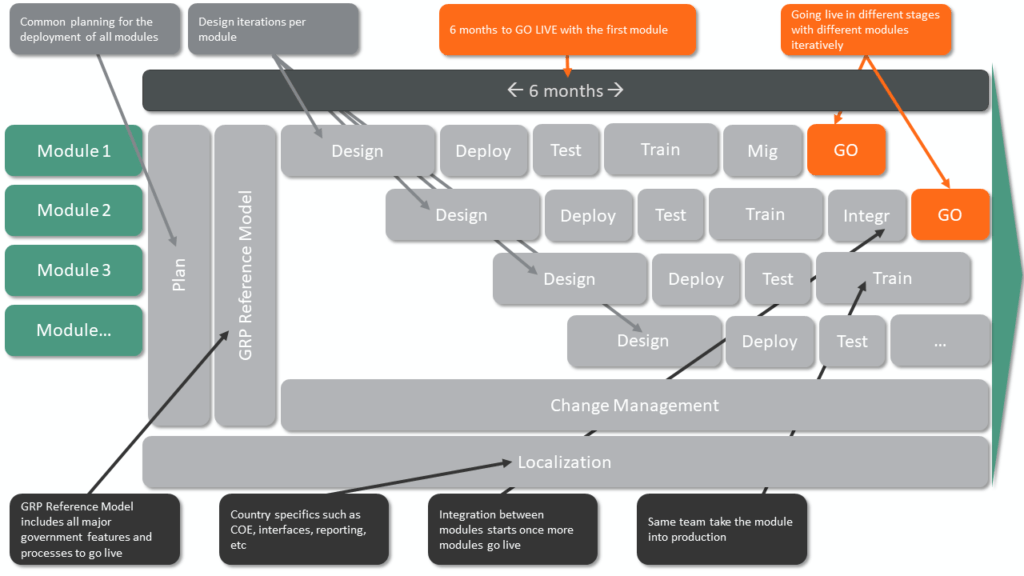
There is less code customization required for the FreeBalance Accountability Suite than traditional COTS applications. The FreeBalance focus on government has enabled the creation of software that is massively configured. Business rules, workflow, additional fields, help, and terminology are all adaptable without any coding. This means no scripting, call-outs or code customization to support these features.
The FreeBalance practice is to place all developed custom code, with the exception of coding for reports or custom interfaces, into the product code base so that it is fully supported. This also eliminates the cost of software upgrades by reducing orphan code that has to be maintained.
FreeBalance uses workshops and storyboards in the development of custom code. The process operates in the following manner:
- Customers are trained with a standard configuration so that product capabilities are understood to minimize customization based on how the previous system operated by analyzing built-in configurable functionality
- A reference configuration, without code customization, is developed in workshops
- Storyboards are used to easily understand new product functionality
- There is a set of validation points from the storyboard through to user acceptance testing
This agile approach accelerates development and implementation compared to the waterfall approach.

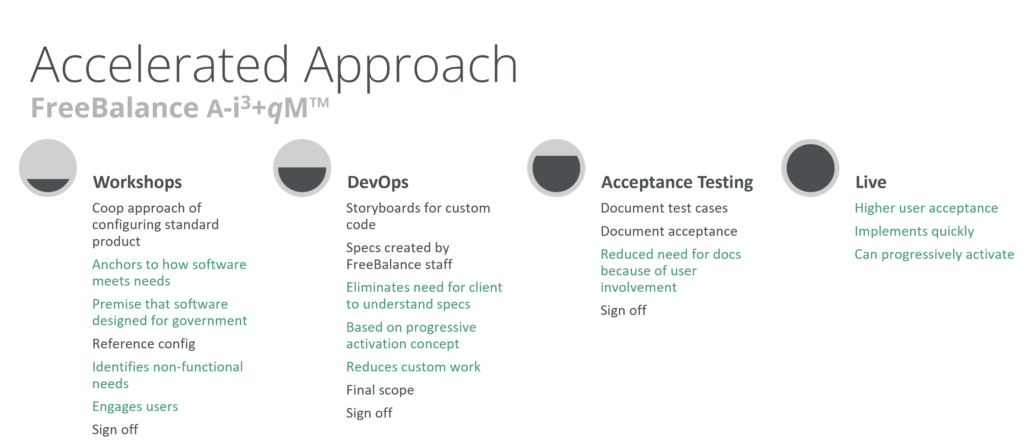
We have found that the traditional waterfall approach of fully documenting all of the current functions, the new functions and the gap significantly slows custom development. It is difficult for public servants to understand detailed technical specifications. It is common to have specifications approved only to discover that the resulting customization fails to meet objectives. Storyboards are more effective.
The specific process of code customization on behalf of customers is shown in the following diagram:
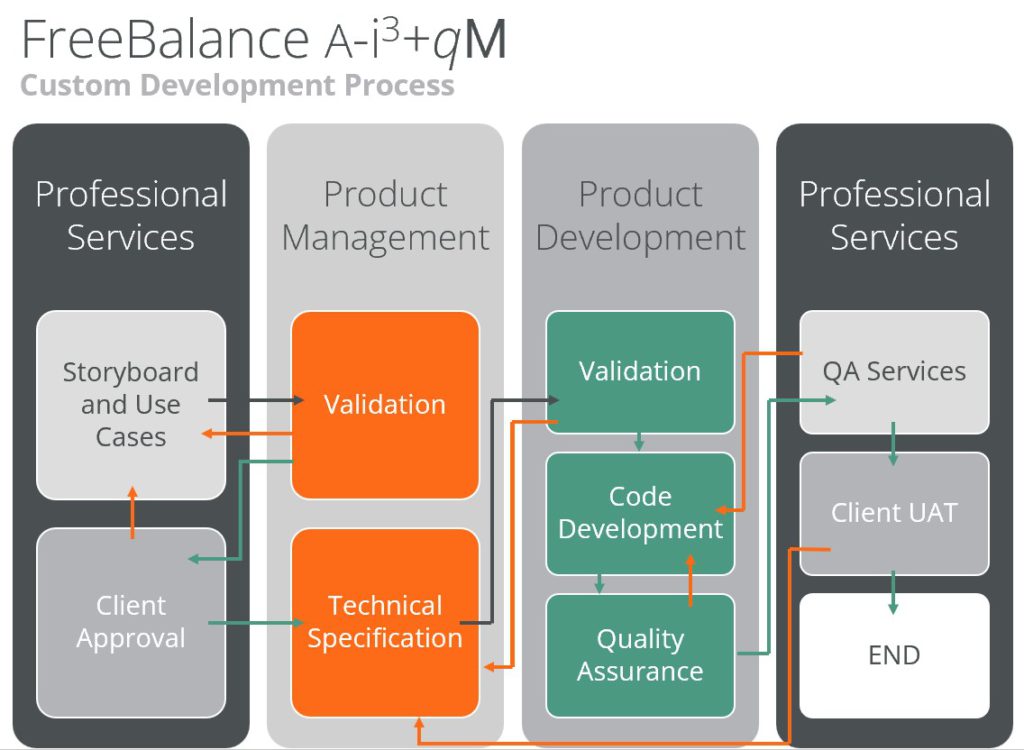
4. Post-Modern Government-Specific Software
Government Design
Unlike most enterprise software, the FreeBalance Accountability Suite, was rewritten from scratch to reflect the latest advances in technology. In particular, the Suite was designed to be massively configured, using many no-code techniques. This is what has become known as “post-modern” enterprise software.
The FreeBalance Accountability Platform, the underlying technology for applications of the FreeBalance Accountability Suite, was designed for massive configuration.
A configuration approach reduces time required to adapt software to meet customer needs, while enables future reform or “progressive activation”. The areas of configuration are unique in the enterprise software industry:
- All business rules are parameterized, all business objects have parameters
- Workflow is configured without code
- Additional fields and tables are configured
- Language and terminology is configured, so that all terms are changed to meet the government terminology
- Documentation and help is configured in a content management system
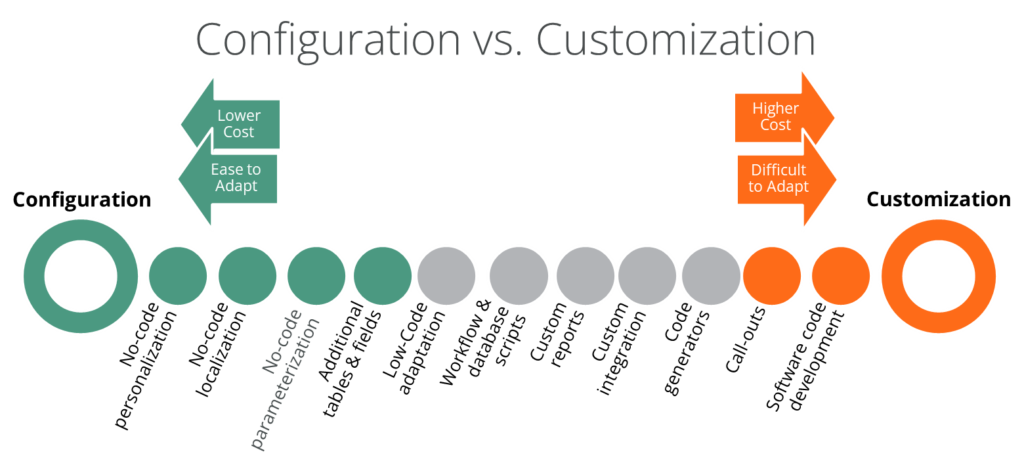
Many enterprise software vendors claim to have achieve “post modern” configurability for on-premises and cloud implementations. These vendors often claim that scripting and call-outs are “configuration”. This is code customization.
Of course, the majority of COTS software, like ERP, was originally designed for business and extended to other industries. These applications have limited configuration footprints for government needs. FreeBalance software is written exclusively for government. This makes it possible to have massively configured GRP.
Financially Sustainable Government Implementations
FreeBalance achieves lower GRP costs through methodology, configuration, commitment, and technology. Is this enough?

One of FreeBalance’s goals is to find ways to reduce TCO further. Price proposals for 5 year multiple phase implementations do not capture all costs. The FreeBalance financial sustainability advantage extends further when cost elements not included in government tenders are evaluated:
- Maintenance and upgrade costs, including need for additional consulting
- Capacity costs based on product complexity, including costs for errors
- Staff retention costs
- Software change costs to support future reform
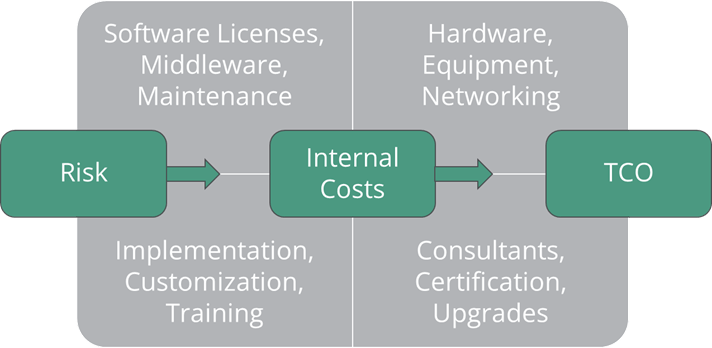
More Reading
- July 14, 2017 Technical Bankruptcy and Government Legacy Systems describes the problem of technical debt
- August 16, 2017 Is FreeBalance the Most Financially Sustainable Government Resource Planning Software? updates price comparisons
- March 17, 2017 A Unique Enterprise Software Product Roadmap Process? describes the use of the FreeBalance International Steering Committee to adapt the FreeBalance product roadmap
- December 27, 2016 Tier 1 vs. FreeBalance TCO Comparison describes the TCO price advantages driven by configuration
- December 19, 2016 Affordable Financial Management Software for Latin American and Caribbean Governments Part 2 describes how GRP software can be financially sustained through improved effectiveness of financial management
- December 12, 2016 Affordable Financial Management Software for Latin American and Caribbean Governments Part 1 describes the FreeBalance approach of government design, capacity building, manufacturer support and change management that makes FreeBalance implementations more financially sustainable
- May 25, 2016 Is FreeBalance Software Expensive describes how FreeBalance keeps software costs low
- January 21, 2013 Customer Centric Processes in Operation provides an overview of the 7th FreeBalance International Steering Committee
- August 15, 2012 Lessons Learned: Calculating the Total Cost of Ownership for Government Resource Planning describes how financial sustainability can be calculated
- April 23, 2012 From Product-Centric to Customer-Centric describes the differences in the two approaches